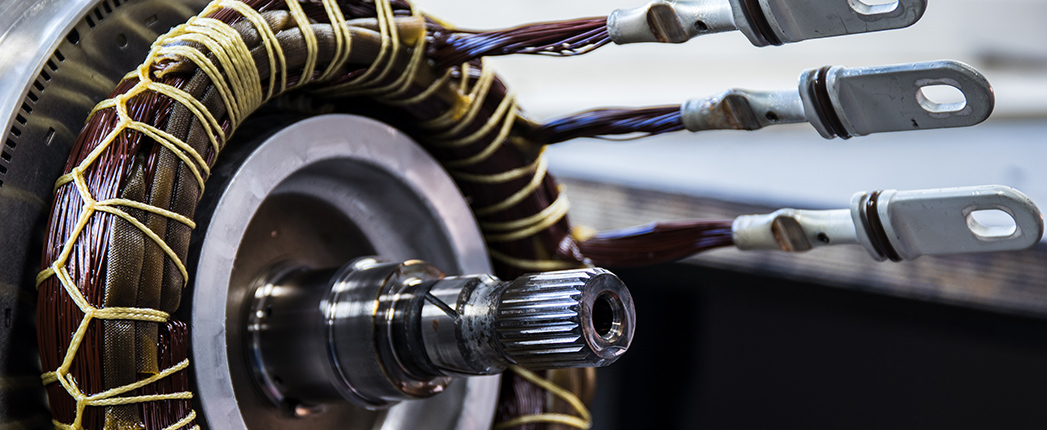
Electrically conductive layer deposits are emerging as a new corrosion concern in electric motors in hybrid and electric vehicles, and developing tests to better evaluate such corrosion is important, a Lubrizol official said during a presentation at an SAE International online event last week.
Senior Research Chemist Gregory Hunt leads corrosion research activities across Lubrizol Transportation. Speaking at SAE International’s World Congress Experience Digital Summit held April 13-15, Hunt said that understanding conductive layer deposits is critical to designing lubricants for electrified devices. He said the issue exists primarily where copper wire in a motor winding becomes exposed due to either the manufacturing process or a wire coating failure during operation. Windings are coiled wire that create a magnetic field.
Hunt explained that if a conducting layer deposit develops, it can connect different phases of the motor winding. “It provides a pathway for current to flow via the deposit,” he said. “In this instance, you’ll get a short circuit. However, it’s much more severe and results in a significant increase in temperature going through the deposit and then the motor winding at that location. This leads to further decomposition of the material and failure of the transmission.”
Tighter carbon dioxide targets are driving original equipment manufacturers to develop more electrified vehicles – hybrids and EVs. “The consequence is that hardware is evolving to enable this transition,” he said, adding that while there are many different options for placing an electric motor in a vehicle, there are also many options about where you place that motor in connection with the transmission.
“The one thing that’s constant at the moment, however, is the use of conventional fluids across all vehicle platforms,” he said. “However, with increased electrification, new hardware designs and heightened lubricant challenges, conventional fluid evaluations may not be good enough.” Lubrizol has undertaken research activities to address concerns around conducting layer deposits, he said.
“Typical corrosion tests focused either qualitatively or quantitatively on the corrosion reaction rate,” he said. “Little is discussed about the nature of the corrosion product or deposit. Even if a lubricant has a lower corrosion rate, it does not preclude the formation of corrosion deposits. Whilst a lower rate of reaction may result in lower levels of corrosion deposits, the nature of these deposits can be problematic, and [they] are a real area of concern as they may lead to failure of the electrified transmission.”
This is one area where conventional lubricant deficiencies due to hardware changes may exist, Hunt noted. “For example, the introduction of the motor winding in contact with the lubricant brings about a new operating condition,” Hunt explained. “There’s a much wider range of temperatures accessible to the lubricant.” He pointed out that the windings in an electrified vehicle’s motor may experience significantly higher temperature spikes, up to 180 degrees Celsius. Vapor corrosion is also a concern with the lubricants on the windings.
“Traditional alloys or metals used in electrified devices can now experience stray currents or be powered as sensors,” he said. “This energized corrosion phenomena can bring about new corrosion concerns when interacting with the lubricant additives.”
Another corrosion concern, he noted, involves the use of the use of electronic control modules or circuits. “One of the concerns here is with conducting layer deposits forming and causing a short circuit in the small spaces between component chips,” he added.
According to Hunt, while conducting layer deposits is a new area of concern for electric motors and lubricants, the micro-electronics industry has examined a similar phenomena in printed circuit board failures since the 1970s.
Hunt said the company designed its Lubrizol Wire Corrosion test to improve copper corrosion evaluation results by providing a direct measure of corrosion rate, either as a result of metal disillusionment or formation of a corrosion layer. “The differences in corrosion rate are useful in determining the corrosion propensity for a given lubricant and have value in differentiating lubricant performance. However, the corrosion rate measurement does not on its own provide information about corrosion product,” he explained. “It’s simply just how quickly corrosion products will form.”
The company has also developed a conductive layer test to characterize the conductivity of the corrosion product in situ.
According to Hunt, Lubrizol has been leaning on the micro-electronics industry for understanding about the issue. “Whilst we have been evaluating conducting layer deposits for over half a decade, this is by no means the only method for evaluating this issue,” he said. “Further method development will demonstrate the need for such evaluations in future lubricant performance tests.”
Hunt said the R&D test can distinguish well between different lubricant performances but that there is currently no industry standard method for assessing conductive layer deposit formation.
“Conducting layer deposits are a concern and should be considered when evaluating lubricants used in electrified devices,” he said. “Changes in conductance can be measured in real time, providing an insight into the conditions that cause deposit formation.”
For more coverage of electric vehicles and their impact on lubricants, subscribe to Lubes’n’Greases’ Electric Vehicles InSite.